Recording Business Transactions: Accounting and Financial Reporting
VerifiedAdded on 2023/01/03
|12
|2134
|66
Report
AI Summary
This report provides a detailed analysis of recording business transactions, encompassing key aspects of financial accounting. It begins with an introduction to business transactions and the role of accounting information for decision-makers, differentiating between internal and external users and outlining their specific needs. The report then delves into the advantages and disadvantages of recording accounting information. The core of the report involves practical application, including the creation of journal entries, followed by the computation of a general ledger and a trial balance. Furthermore, the report calculates an income statement and discusses the potential impacts of COVID-19 on various income statement items, providing a real-world perspective on financial analysis. The report concludes with a summary of the findings and a list of references.
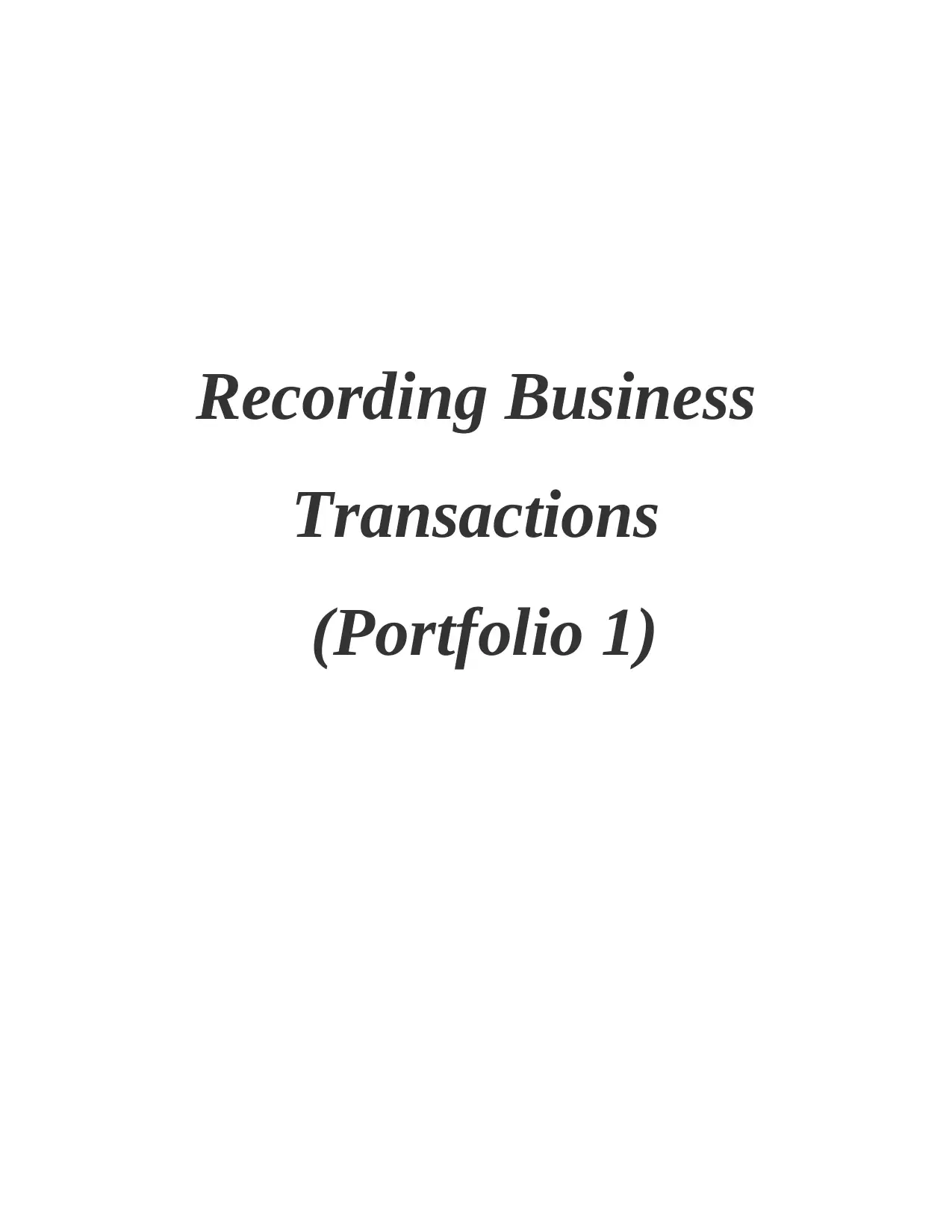
Recording Business
Transactions
(Portfolio 1)
Transactions
(Portfolio 1)
Paraphrase This Document
Need a fresh take? Get an instant paraphrase of this document with our AI Paraphraser
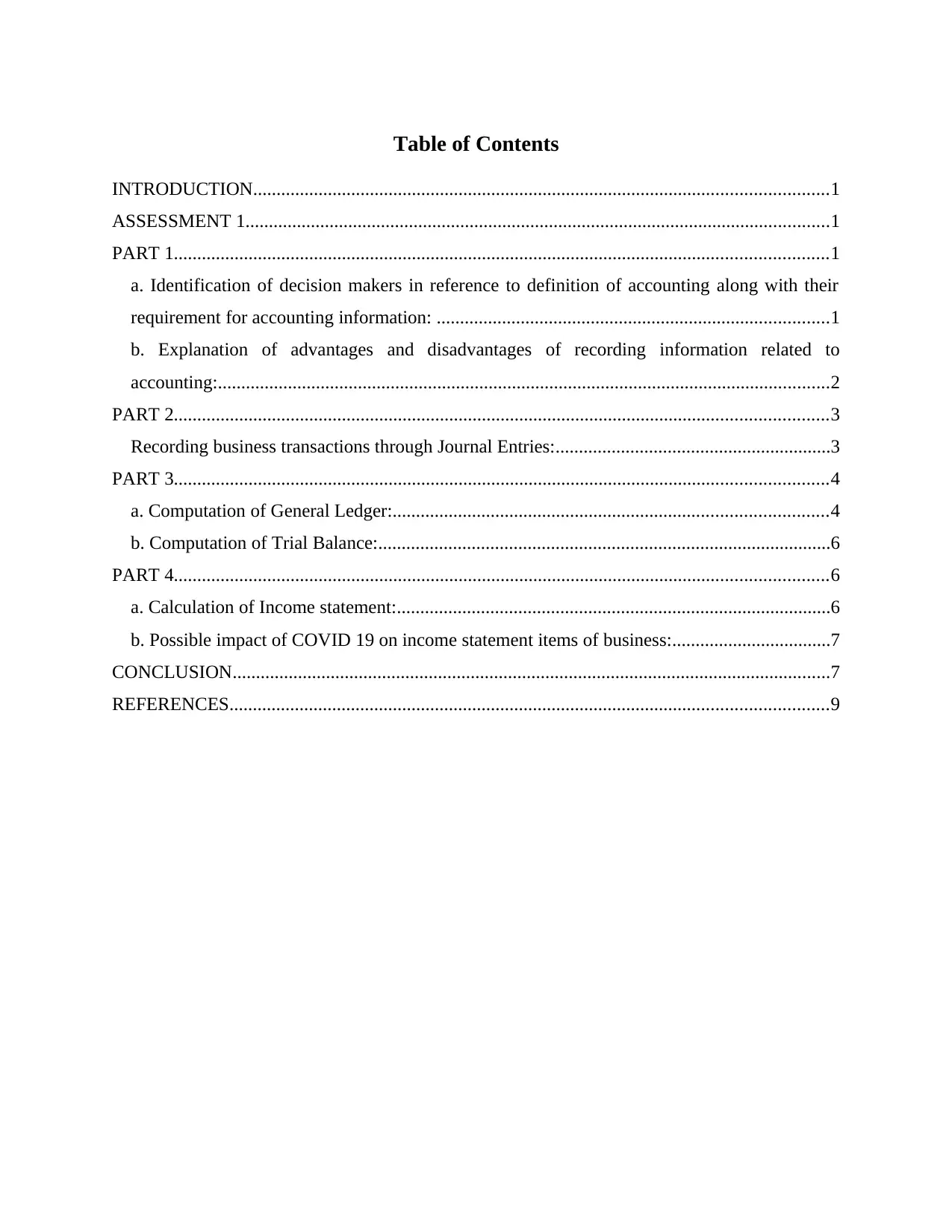
Table of Contents
INTRODUCTION...........................................................................................................................1
ASSESSMENT 1.............................................................................................................................1
PART 1............................................................................................................................................1
a. Identification of decision makers in reference to definition of accounting along with their
requirement for accounting information: ....................................................................................1
b. Explanation of advantages and disadvantages of recording information related to
accounting:...................................................................................................................................2
PART 2............................................................................................................................................3
Recording business transactions through Journal Entries:...........................................................3
PART 3............................................................................................................................................4
a. Computation of General Ledger:.............................................................................................4
b. Computation of Trial Balance:.................................................................................................6
PART 4............................................................................................................................................6
a. Calculation of Income statement:.............................................................................................6
b. Possible impact of COVID 19 on income statement items of business:..................................7
CONCLUSION................................................................................................................................7
REFERENCES................................................................................................................................9
INTRODUCTION...........................................................................................................................1
ASSESSMENT 1.............................................................................................................................1
PART 1............................................................................................................................................1
a. Identification of decision makers in reference to definition of accounting along with their
requirement for accounting information: ....................................................................................1
b. Explanation of advantages and disadvantages of recording information related to
accounting:...................................................................................................................................2
PART 2............................................................................................................................................3
Recording business transactions through Journal Entries:...........................................................3
PART 3............................................................................................................................................4
a. Computation of General Ledger:.............................................................................................4
b. Computation of Trial Balance:.................................................................................................6
PART 4............................................................................................................................................6
a. Calculation of Income statement:.............................................................................................6
b. Possible impact of COVID 19 on income statement items of business:..................................7
CONCLUSION................................................................................................................................7
REFERENCES................................................................................................................................9
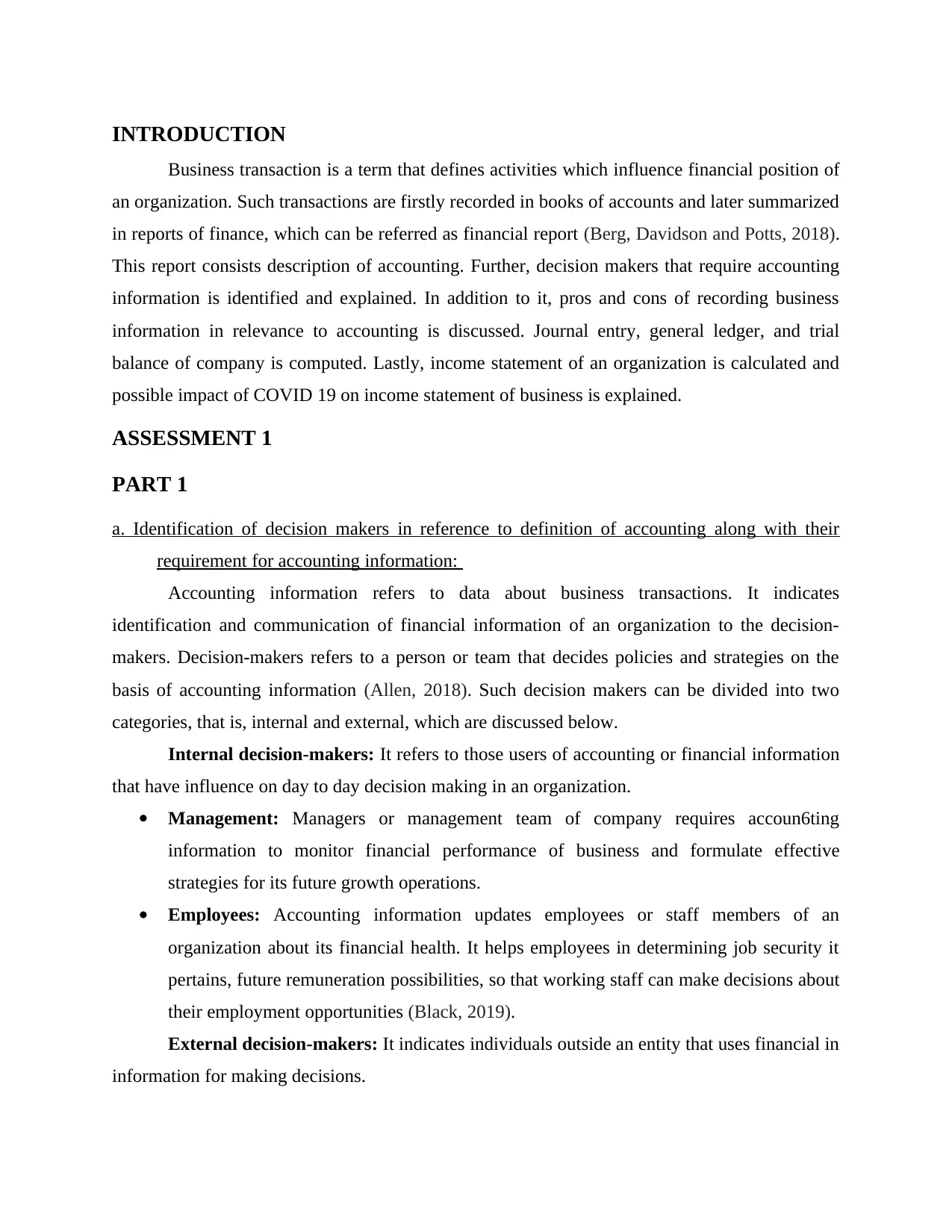
INTRODUCTION
Business transaction is a term that defines activities which influence financial position of
an organization. Such transactions are firstly recorded in books of accounts and later summarized
in reports of finance, which can be referred as financial report (Berg, Davidson and Potts, 2018).
This report consists description of accounting. Further, decision makers that require accounting
information is identified and explained. In addition to it, pros and cons of recording business
information in relevance to accounting is discussed. Journal entry, general ledger, and trial
balance of company is computed. Lastly, income statement of an organization is calculated and
possible impact of COVID 19 on income statement of business is explained.
ASSESSMENT 1
PART 1
a. Identification of decision makers in reference to definition of accounting along with their
requirement for accounting information:
Accounting information refers to data about business transactions. It indicates
identification and communication of financial information of an organization to the decision-
makers. Decision-makers refers to a person or team that decides policies and strategies on the
basis of accounting information (Allen, 2018). Such decision makers can be divided into two
categories, that is, internal and external, which are discussed below.
Internal decision-makers: It refers to those users of accounting or financial information
that have influence on day to day decision making in an organization.
Management: Managers or management team of company requires accoun6ting
information to monitor financial performance of business and formulate effective
strategies for its future growth operations.
Employees: Accounting information updates employees or staff members of an
organization about its financial health. It helps employees in determining job security it
pertains, future remuneration possibilities, so that working staff can make decisions about
their employment opportunities (Black, 2019).
External decision-makers: It indicates individuals outside an entity that uses financial in
information for making decisions.
Business transaction is a term that defines activities which influence financial position of
an organization. Such transactions are firstly recorded in books of accounts and later summarized
in reports of finance, which can be referred as financial report (Berg, Davidson and Potts, 2018).
This report consists description of accounting. Further, decision makers that require accounting
information is identified and explained. In addition to it, pros and cons of recording business
information in relevance to accounting is discussed. Journal entry, general ledger, and trial
balance of company is computed. Lastly, income statement of an organization is calculated and
possible impact of COVID 19 on income statement of business is explained.
ASSESSMENT 1
PART 1
a. Identification of decision makers in reference to definition of accounting along with their
requirement for accounting information:
Accounting information refers to data about business transactions. It indicates
identification and communication of financial information of an organization to the decision-
makers. Decision-makers refers to a person or team that decides policies and strategies on the
basis of accounting information (Allen, 2018). Such decision makers can be divided into two
categories, that is, internal and external, which are discussed below.
Internal decision-makers: It refers to those users of accounting or financial information
that have influence on day to day decision making in an organization.
Management: Managers or management team of company requires accoun6ting
information to monitor financial performance of business and formulate effective
strategies for its future growth operations.
Employees: Accounting information updates employees or staff members of an
organization about its financial health. It helps employees in determining job security it
pertains, future remuneration possibilities, so that working staff can make decisions about
their employment opportunities (Black, 2019).
External decision-makers: It indicates individuals outside an entity that uses financial in
information for making decisions.
⊘ This is a preview!⊘
Do you want full access?
Subscribe today to unlock all pages.

Trusted by 1+ million students worldwide
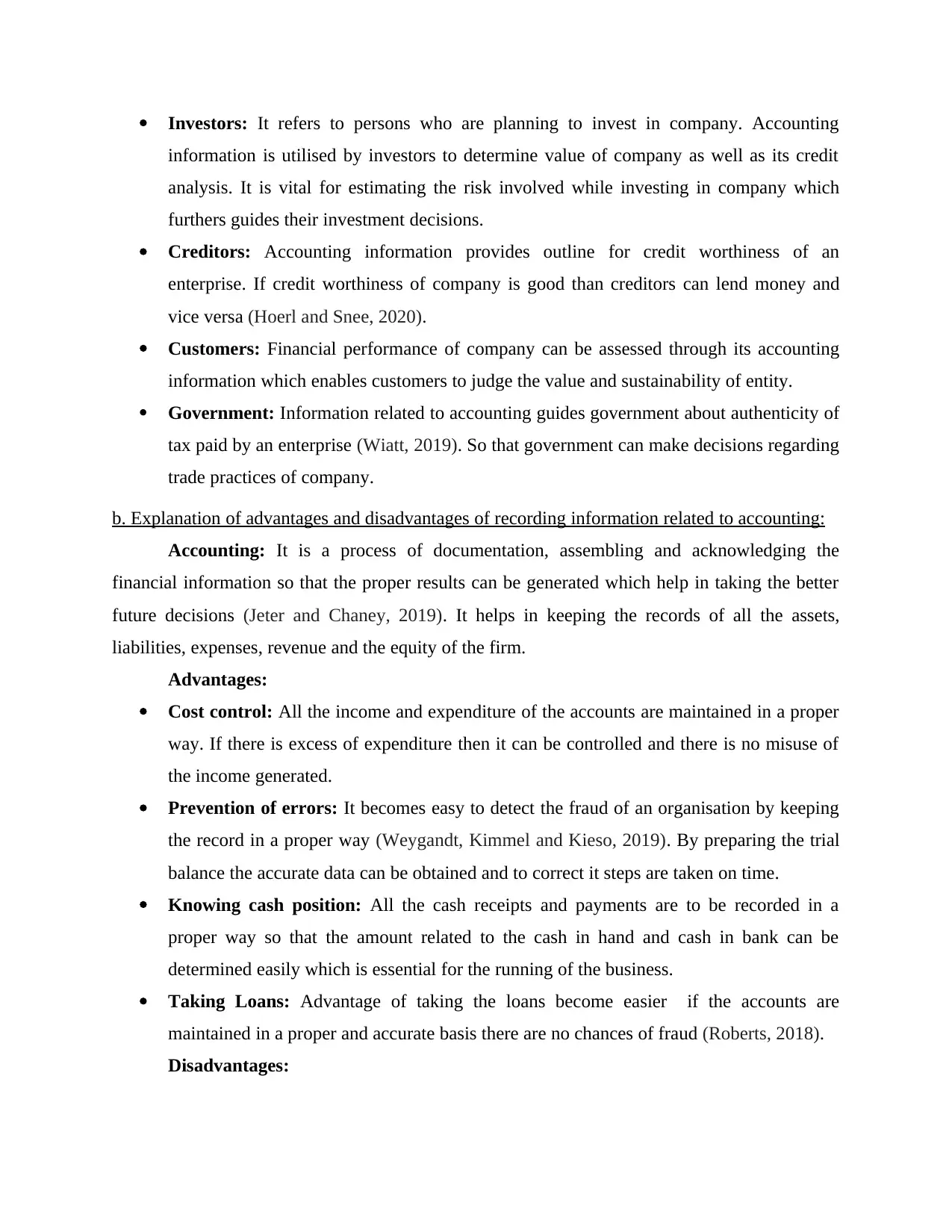
Investors: It refers to persons who are planning to invest in company. Accounting
information is utilised by investors to determine value of company as well as its credit
analysis. It is vital for estimating the risk involved while investing in company which
furthers guides their investment decisions.
Creditors: Accounting information provides outline for credit worthiness of an
enterprise. If credit worthiness of company is good than creditors can lend money and
vice versa (Hoerl and Snee, 2020).
Customers: Financial performance of company can be assessed through its accounting
information which enables customers to judge the value and sustainability of entity.
Government: Information related to accounting guides government about authenticity of
tax paid by an enterprise (Wiatt, 2019). So that government can make decisions regarding
trade practices of company.
b. Explanation of advantages and disadvantages of recording information related to accounting:
Accounting: It is a process of documentation, assembling and acknowledging the
financial information so that the proper results can be generated which help in taking the better
future decisions (Jeter and Chaney, 2019). It helps in keeping the records of all the assets,
liabilities, expenses, revenue and the equity of the firm.
Advantages:
Cost control: All the income and expenditure of the accounts are maintained in a proper
way. If there is excess of expenditure then it can be controlled and there is no misuse of
the income generated.
Prevention of errors: It becomes easy to detect the fraud of an organisation by keeping
the record in a proper way (Weygandt, Kimmel and Kieso, 2019). By preparing the trial
balance the accurate data can be obtained and to correct it steps are taken on time.
Knowing cash position: All the cash receipts and payments are to be recorded in a
proper way so that the amount related to the cash in hand and cash in bank can be
determined easily which is essential for the running of the business.
Taking Loans: Advantage of taking the loans become easier if the accounts are
maintained in a proper and accurate basis there are no chances of fraud (Roberts, 2018).
Disadvantages:
information is utilised by investors to determine value of company as well as its credit
analysis. It is vital for estimating the risk involved while investing in company which
furthers guides their investment decisions.
Creditors: Accounting information provides outline for credit worthiness of an
enterprise. If credit worthiness of company is good than creditors can lend money and
vice versa (Hoerl and Snee, 2020).
Customers: Financial performance of company can be assessed through its accounting
information which enables customers to judge the value and sustainability of entity.
Government: Information related to accounting guides government about authenticity of
tax paid by an enterprise (Wiatt, 2019). So that government can make decisions regarding
trade practices of company.
b. Explanation of advantages and disadvantages of recording information related to accounting:
Accounting: It is a process of documentation, assembling and acknowledging the
financial information so that the proper results can be generated which help in taking the better
future decisions (Jeter and Chaney, 2019). It helps in keeping the records of all the assets,
liabilities, expenses, revenue and the equity of the firm.
Advantages:
Cost control: All the income and expenditure of the accounts are maintained in a proper
way. If there is excess of expenditure then it can be controlled and there is no misuse of
the income generated.
Prevention of errors: It becomes easy to detect the fraud of an organisation by keeping
the record in a proper way (Weygandt, Kimmel and Kieso, 2019). By preparing the trial
balance the accurate data can be obtained and to correct it steps are taken on time.
Knowing cash position: All the cash receipts and payments are to be recorded in a
proper way so that the amount related to the cash in hand and cash in bank can be
determined easily which is essential for the running of the business.
Taking Loans: Advantage of taking the loans become easier if the accounts are
maintained in a proper and accurate basis there are no chances of fraud (Roberts, 2018).
Disadvantages:
Paraphrase This Document
Need a fresh take? Get an instant paraphrase of this document with our AI Paraphraser
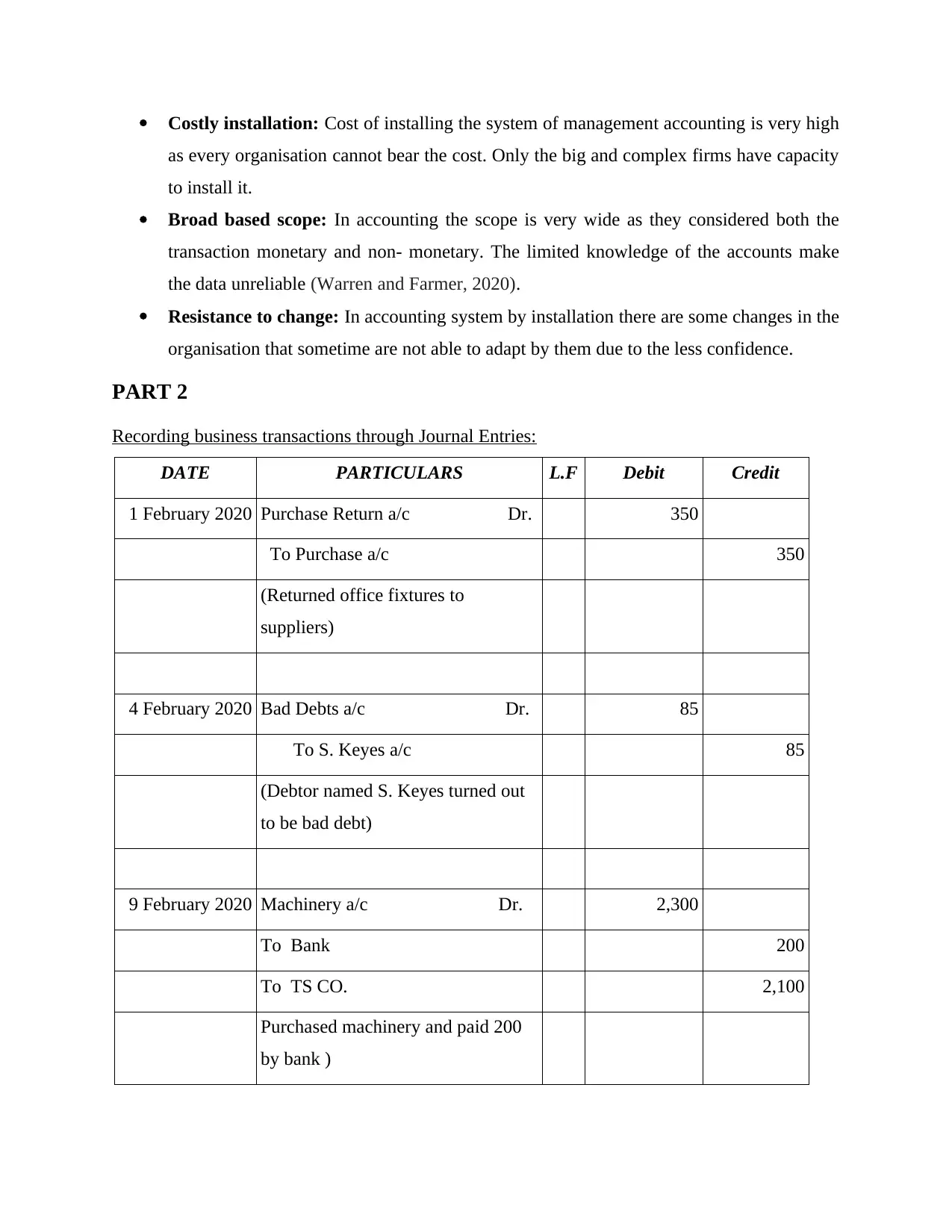
Costly installation: Cost of installing the system of management accounting is very high
as every organisation cannot bear the cost. Only the big and complex firms have capacity
to install it.
Broad based scope: In accounting the scope is very wide as they considered both the
transaction monetary and non- monetary. The limited knowledge of the accounts make
the data unreliable (Warren and Farmer, 2020).
Resistance to change: In accounting system by installation there are some changes in the
organisation that sometime are not able to adapt by them due to the less confidence.
PART 2
Recording business transactions through Journal Entries:
DATE PARTICULARS L.F Debit Credit
1 February 2020 Purchase Return a/c Dr. 350
To Purchase a/c 350
(Returned office fixtures to
suppliers)
4 February 2020 Bad Debts a/c Dr. 85
To S. Keyes a/c 85
(Debtor named S. Keyes turned out
to be bad debt)
9 February 2020 Machinery a/c Dr. 2,300
To Bank 200
To TS CO. 2,100
Purchased machinery and paid 200
by bank )
as every organisation cannot bear the cost. Only the big and complex firms have capacity
to install it.
Broad based scope: In accounting the scope is very wide as they considered both the
transaction monetary and non- monetary. The limited knowledge of the accounts make
the data unreliable (Warren and Farmer, 2020).
Resistance to change: In accounting system by installation there are some changes in the
organisation that sometime are not able to adapt by them due to the less confidence.
PART 2
Recording business transactions through Journal Entries:
DATE PARTICULARS L.F Debit Credit
1 February 2020 Purchase Return a/c Dr. 350
To Purchase a/c 350
(Returned office fixtures to
suppliers)
4 February 2020 Bad Debts a/c Dr. 85
To S. Keyes a/c 85
(Debtor named S. Keyes turned out
to be bad debt)
9 February 2020 Machinery a/c Dr. 2,300
To Bank 200
To TS CO. 2,100
Purchased machinery and paid 200
by bank )
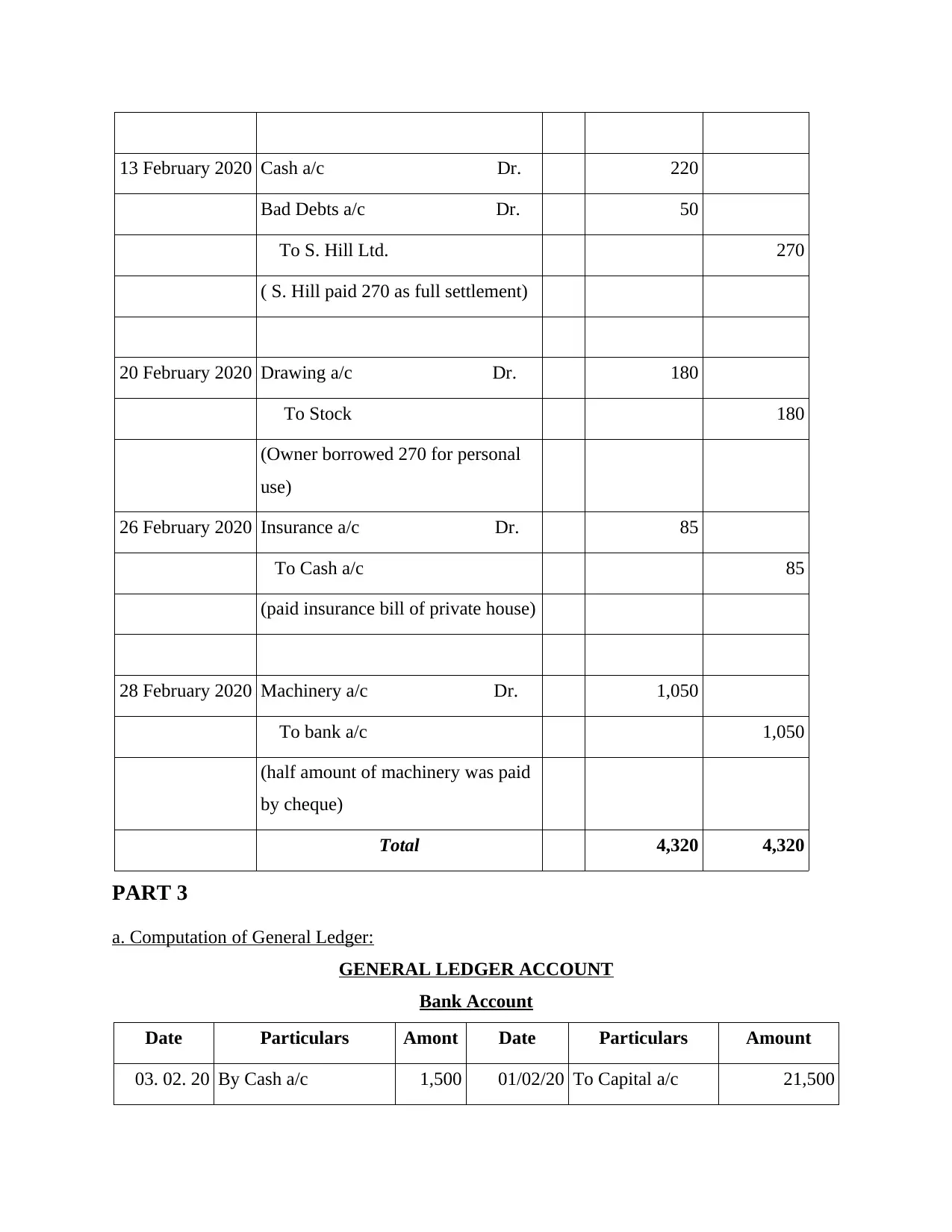
13 February 2020 Cash a/c Dr. 220
Bad Debts a/c Dr. 50
To S. Hill Ltd. 270
( S. Hill paid 270 as full settlement)
20 February 2020 Drawing a/c Dr. 180
To Stock 180
(Owner borrowed 270 for personal
use)
26 February 2020 Insurance a/c Dr. 85
To Cash a/c 85
(paid insurance bill of private house)
28 February 2020 Machinery a/c Dr. 1,050
To bank a/c 1,050
(half amount of machinery was paid
by cheque)
Total 4,320 4,320
PART 3
a. Computation of General Ledger:
GENERAL LEDGER ACCOUNT
Bank Account
Date Particulars Amont Date Particulars Amount
03. 02. 20 By Cash a/c 1,500 01/02/20 To Capital a/c 21,500
Bad Debts a/c Dr. 50
To S. Hill Ltd. 270
( S. Hill paid 270 as full settlement)
20 February 2020 Drawing a/c Dr. 180
To Stock 180
(Owner borrowed 270 for personal
use)
26 February 2020 Insurance a/c Dr. 85
To Cash a/c 85
(paid insurance bill of private house)
28 February 2020 Machinery a/c Dr. 1,050
To bank a/c 1,050
(half amount of machinery was paid
by cheque)
Total 4,320 4,320
PART 3
a. Computation of General Ledger:
GENERAL LEDGER ACCOUNT
Bank Account
Date Particulars Amont Date Particulars Amount
03. 02. 20 By Cash a/c 1,500 01/02/20 To Capital a/c 21,500
⊘ This is a preview!⊘
Do you want full access?
Subscribe today to unlock all pages.

Trusted by 1+ million students worldwide
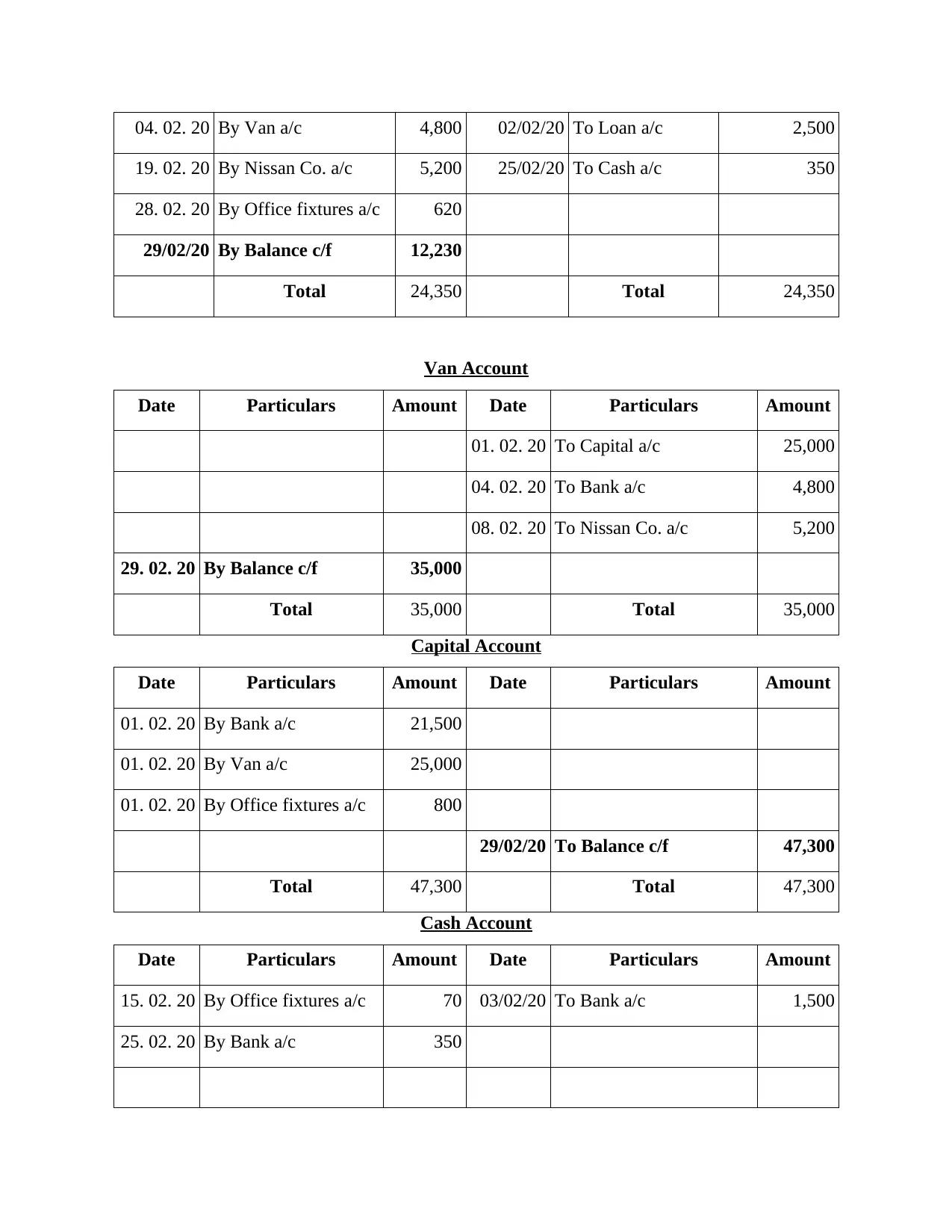
04. 02. 20 By Van a/c 4,800 02/02/20 To Loan a/c 2,500
19. 02. 20 By Nissan Co. a/c 5,200 25/02/20 To Cash a/c 350
28. 02. 20 By Office fixtures a/c 620
29/02/20 By Balance c/f 12,230
Total 24,350 Total 24,350
Van Account
Date Particulars Amount Date Particulars Amount
01. 02. 20 To Capital a/c 25,000
04. 02. 20 To Bank a/c 4,800
08. 02. 20 To Nissan Co. a/c 5,200
29. 02. 20 By Balance c/f 35,000
Total 35,000 Total 35,000
Capital Account
Date Particulars Amount Date Particulars Amount
01. 02. 20 By Bank a/c 21,500
01. 02. 20 By Van a/c 25,000
01. 02. 20 By Office fixtures a/c 800
29/02/20 To Balance c/f 47,300
Total 47,300 Total 47,300
Cash Account
Date Particulars Amount Date Particulars Amount
15. 02. 20 By Office fixtures a/c 70 03/02/20 To Bank a/c 1,500
25. 02. 20 By Bank a/c 350
19. 02. 20 By Nissan Co. a/c 5,200 25/02/20 To Cash a/c 350
28. 02. 20 By Office fixtures a/c 620
29/02/20 By Balance c/f 12,230
Total 24,350 Total 24,350
Van Account
Date Particulars Amount Date Particulars Amount
01. 02. 20 To Capital a/c 25,000
04. 02. 20 To Bank a/c 4,800
08. 02. 20 To Nissan Co. a/c 5,200
29. 02. 20 By Balance c/f 35,000
Total 35,000 Total 35,000
Capital Account
Date Particulars Amount Date Particulars Amount
01. 02. 20 By Bank a/c 21,500
01. 02. 20 By Van a/c 25,000
01. 02. 20 By Office fixtures a/c 800
29/02/20 To Balance c/f 47,300
Total 47,300 Total 47,300
Cash Account
Date Particulars Amount Date Particulars Amount
15. 02. 20 By Office fixtures a/c 70 03/02/20 To Bank a/c 1,500
25. 02. 20 By Bank a/c 350
Paraphrase This Document
Need a fresh take? Get an instant paraphrase of this document with our AI Paraphraser
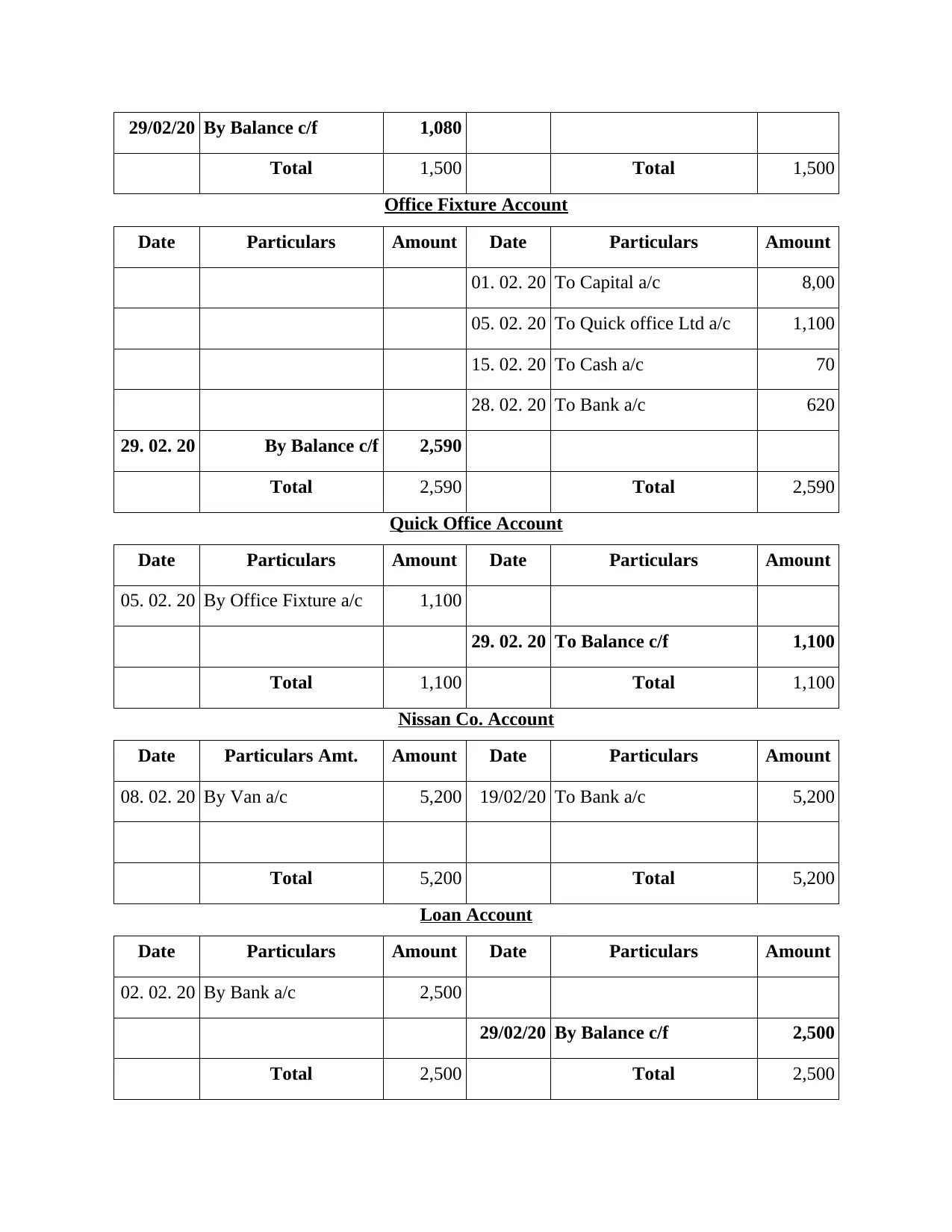
29/02/20 By Balance c/f 1,080
Total 1,500 Total 1,500
Office Fixture Account
Date Particulars Amount Date Particulars Amount
01. 02. 20 To Capital a/c 8,00
05. 02. 20 To Quick office Ltd a/c 1,100
15. 02. 20 To Cash a/c 70
28. 02. 20 To Bank a/c 620
29. 02. 20 By Balance c/f 2,590
Total 2,590 Total 2,590
Quick Office Account
Date Particulars Amount Date Particulars Amount
05. 02. 20 By Office Fixture a/c 1,100
29. 02. 20 To Balance c/f 1,100
Total 1,100 Total 1,100
Nissan Co. Account
Date Particulars Amt. Amount Date Particulars Amount
08. 02. 20 By Van a/c 5,200 19/02/20 To Bank a/c 5,200
Total 5,200 Total 5,200
Loan Account
Date Particulars Amount Date Particulars Amount
02. 02. 20 By Bank a/c 2,500
29/02/20 By Balance c/f 2,500
Total 2,500 Total 2,500
Total 1,500 Total 1,500
Office Fixture Account
Date Particulars Amount Date Particulars Amount
01. 02. 20 To Capital a/c 8,00
05. 02. 20 To Quick office Ltd a/c 1,100
15. 02. 20 To Cash a/c 70
28. 02. 20 To Bank a/c 620
29. 02. 20 By Balance c/f 2,590
Total 2,590 Total 2,590
Quick Office Account
Date Particulars Amount Date Particulars Amount
05. 02. 20 By Office Fixture a/c 1,100
29. 02. 20 To Balance c/f 1,100
Total 1,100 Total 1,100
Nissan Co. Account
Date Particulars Amt. Amount Date Particulars Amount
08. 02. 20 By Van a/c 5,200 19/02/20 To Bank a/c 5,200
Total 5,200 Total 5,200
Loan Account
Date Particulars Amount Date Particulars Amount
02. 02. 20 By Bank a/c 2,500
29/02/20 By Balance c/f 2,500
Total 2,500 Total 2,500
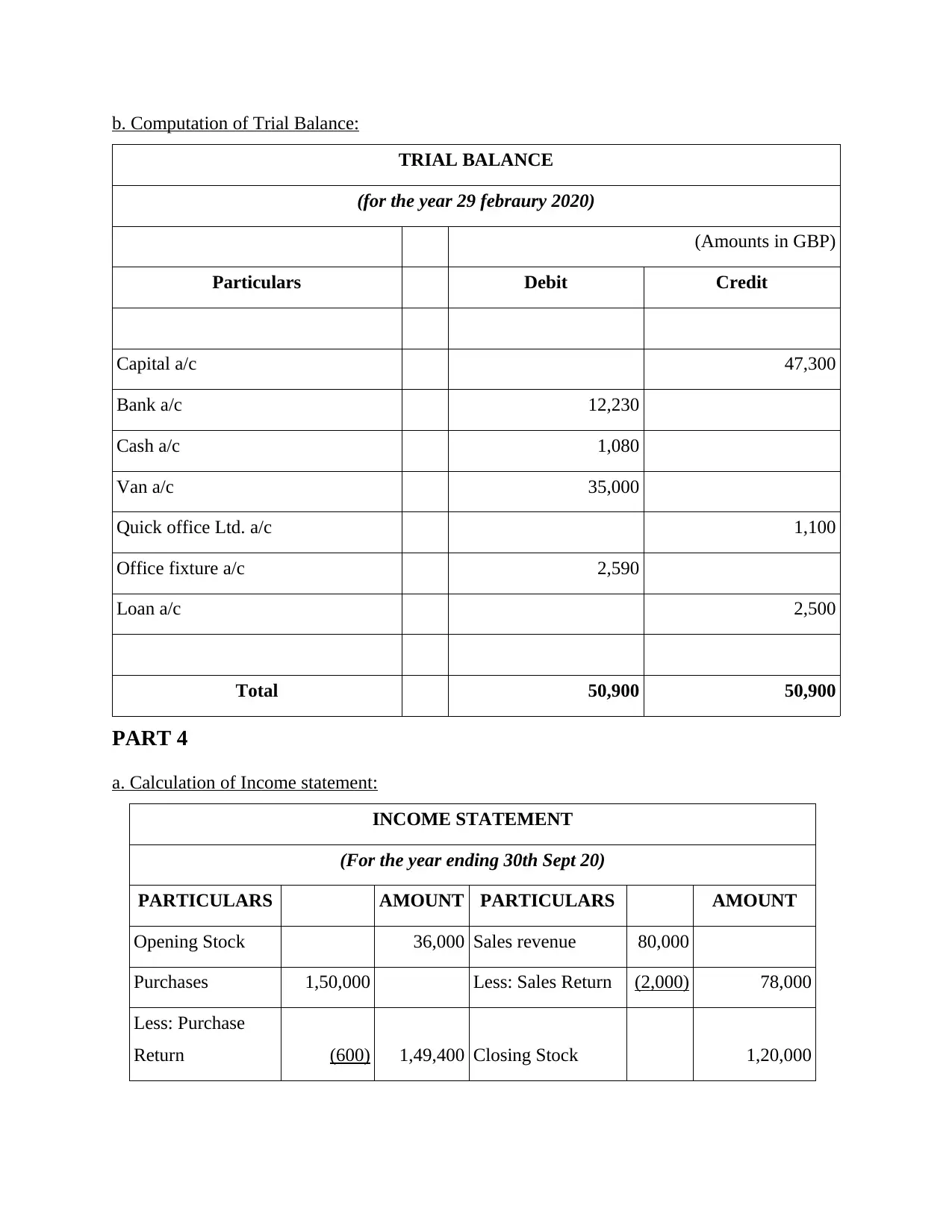
b. Computation of Trial Balance:
TRIAL BALANCE
(for the year 29 febraury 2020)
(Amounts in GBP)
Particulars Debit Credit
Capital a/c 47,300
Bank a/c 12,230
Cash a/c 1,080
Van a/c 35,000
Quick office Ltd. a/c 1,100
Office fixture a/c 2,590
Loan a/c 2,500
Total 50,900 50,900
PART 4
a. Calculation of Income statement:
INCOME STATEMENT
(For the year ending 30th Sept 20)
PARTICULARS AMOUNT PARTICULARS AMOUNT
Opening Stock 36,000 Sales revenue 80,000
Purchases 1,50,000 Less: Sales Return (2,000) 78,000
Less: Purchase
Return (600) 1,49,400 Closing Stock 1,20,000
TRIAL BALANCE
(for the year 29 febraury 2020)
(Amounts in GBP)
Particulars Debit Credit
Capital a/c 47,300
Bank a/c 12,230
Cash a/c 1,080
Van a/c 35,000
Quick office Ltd. a/c 1,100
Office fixture a/c 2,590
Loan a/c 2,500
Total 50,900 50,900
PART 4
a. Calculation of Income statement:
INCOME STATEMENT
(For the year ending 30th Sept 20)
PARTICULARS AMOUNT PARTICULARS AMOUNT
Opening Stock 36,000 Sales revenue 80,000
Purchases 1,50,000 Less: Sales Return (2,000) 78,000
Less: Purchase
Return (600) 1,49,400 Closing Stock 1,20,000
⊘ This is a preview!⊘
Do you want full access?
Subscribe today to unlock all pages.

Trusted by 1+ million students worldwide
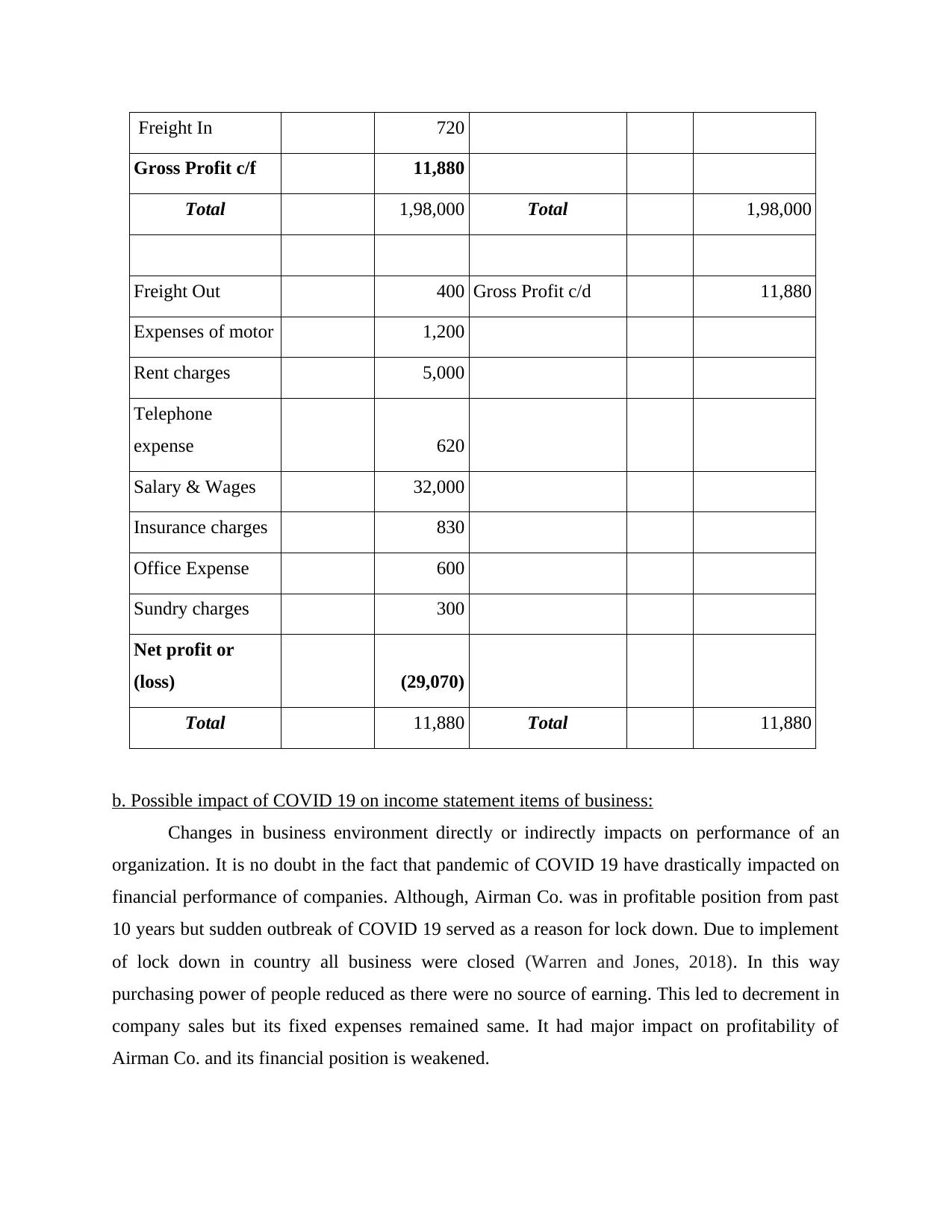
Freight In 720
Gross Profit c/f 11,880
Total 1,98,000 Total 1,98,000
Freight Out 400 Gross Profit c/d 11,880
Expenses of motor 1,200
Rent charges 5,000
Telephone
expense 620
Salary & Wages 32,000
Insurance charges 830
Office Expense 600
Sundry charges 300
Net profit or
(loss) (29,070)
Total 11,880 Total 11,880
b. Possible impact of COVID 19 on income statement items of business:
Changes in business environment directly or indirectly impacts on performance of an
organization. It is no doubt in the fact that pandemic of COVID 19 have drastically impacted on
financial performance of companies. Although, Airman Co. was in profitable position from past
10 years but sudden outbreak of COVID 19 served as a reason for lock down. Due to implement
of lock down in country all business were closed (Warren and Jones, 2018). In this way
purchasing power of people reduced as there were no source of earning. This led to decrement in
company sales but its fixed expenses remained same. It had major impact on profitability of
Airman Co. and its financial position is weakened.
Gross Profit c/f 11,880
Total 1,98,000 Total 1,98,000
Freight Out 400 Gross Profit c/d 11,880
Expenses of motor 1,200
Rent charges 5,000
Telephone
expense 620
Salary & Wages 32,000
Insurance charges 830
Office Expense 600
Sundry charges 300
Net profit or
(loss) (29,070)
Total 11,880 Total 11,880
b. Possible impact of COVID 19 on income statement items of business:
Changes in business environment directly or indirectly impacts on performance of an
organization. It is no doubt in the fact that pandemic of COVID 19 have drastically impacted on
financial performance of companies. Although, Airman Co. was in profitable position from past
10 years but sudden outbreak of COVID 19 served as a reason for lock down. Due to implement
of lock down in country all business were closed (Warren and Jones, 2018). In this way
purchasing power of people reduced as there were no source of earning. This led to decrement in
company sales but its fixed expenses remained same. It had major impact on profitability of
Airman Co. and its financial position is weakened.
Paraphrase This Document
Need a fresh take? Get an instant paraphrase of this document with our AI Paraphraser
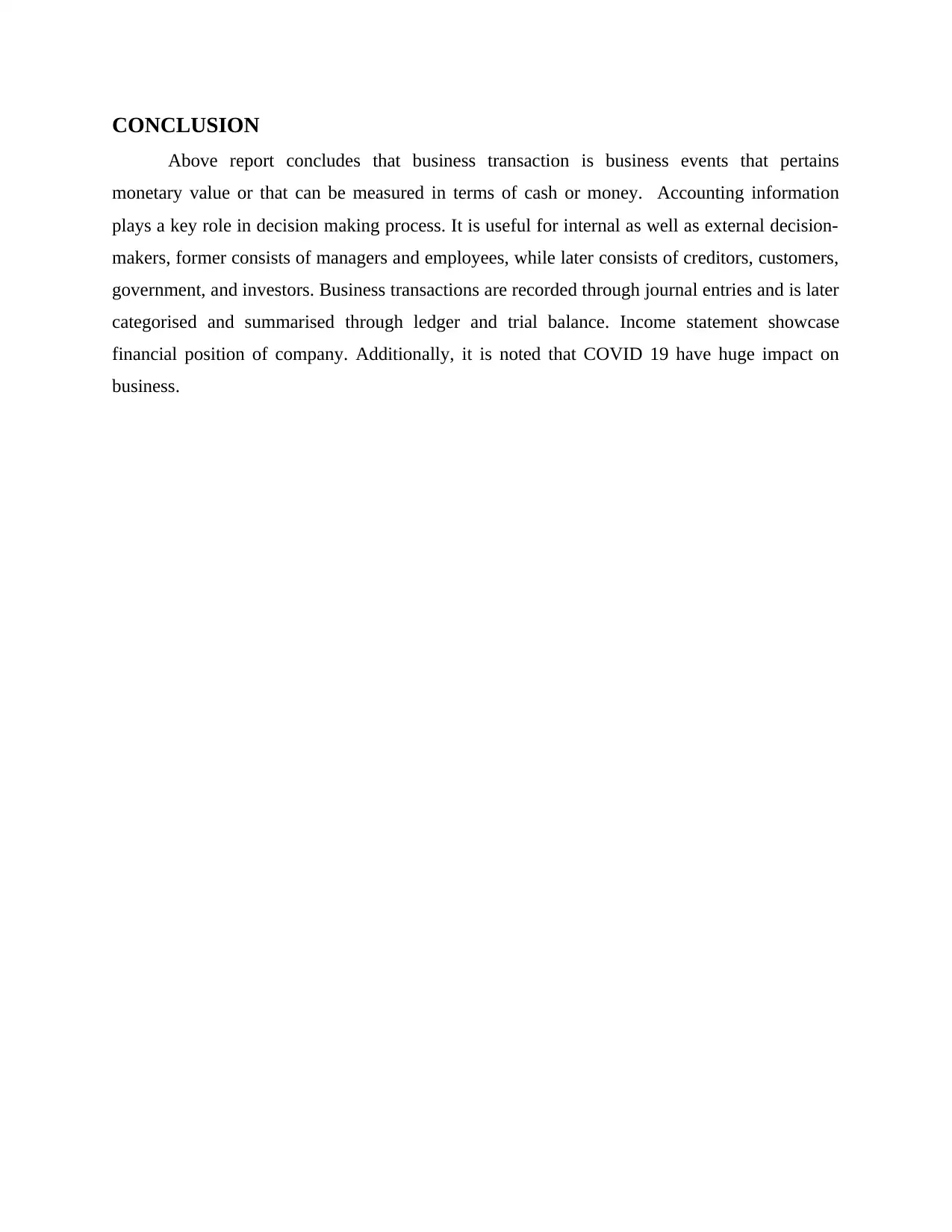
CONCLUSION
Above report concludes that business transaction is business events that pertains
monetary value or that can be measured in terms of cash or money. Accounting information
plays a key role in decision making process. It is useful for internal as well as external decision-
makers, former consists of managers and employees, while later consists of creditors, customers,
government, and investors. Business transactions are recorded through journal entries and is later
categorised and summarised through ledger and trial balance. Income statement showcase
financial position of company. Additionally, it is noted that COVID 19 have huge impact on
business.
Above report concludes that business transaction is business events that pertains
monetary value or that can be measured in terms of cash or money. Accounting information
plays a key role in decision making process. It is useful for internal as well as external decision-
makers, former consists of managers and employees, while later consists of creditors, customers,
government, and investors. Business transactions are recorded through journal entries and is later
categorised and summarised through ledger and trial balance. Income statement showcase
financial position of company. Additionally, it is noted that COVID 19 have huge impact on
business.
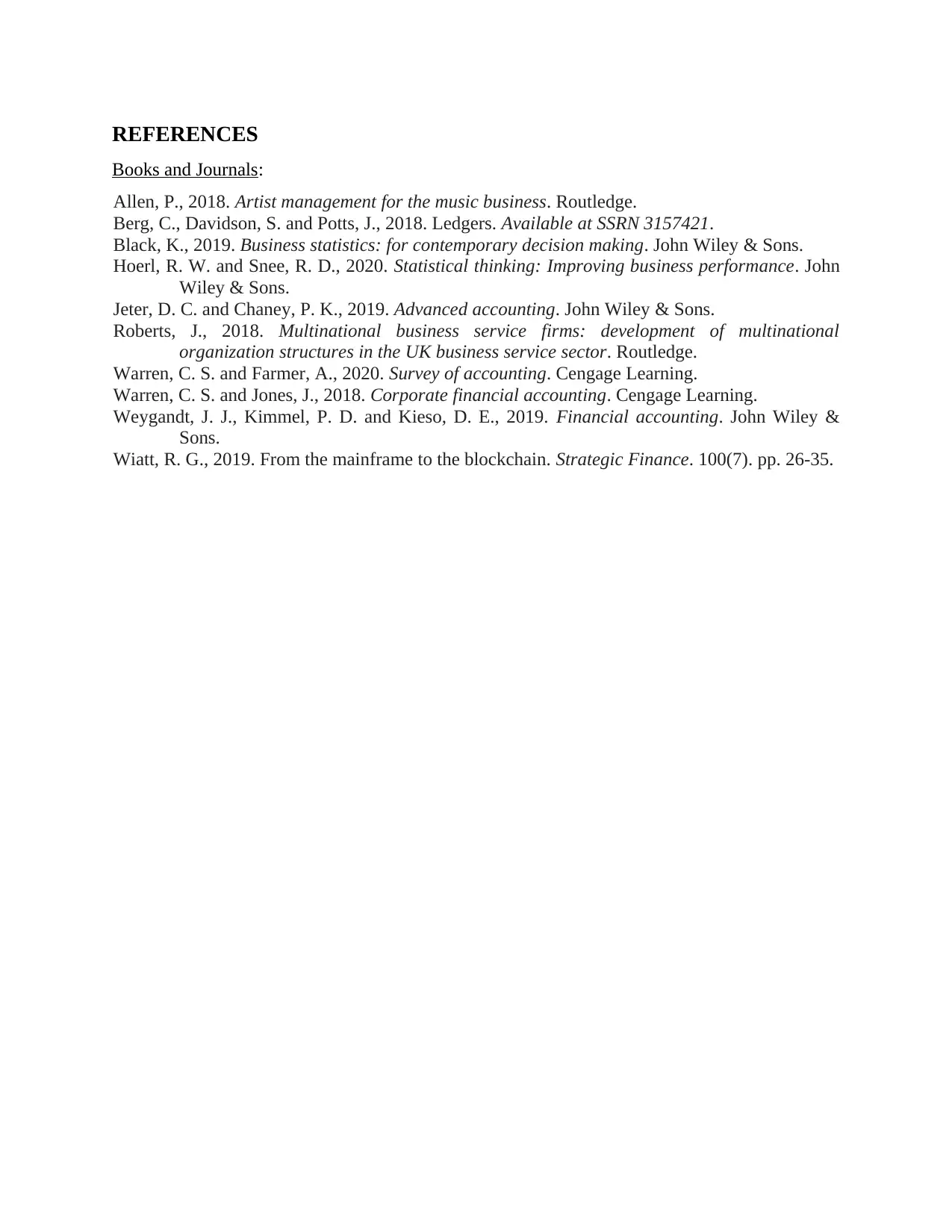
REFERENCES
Books and Journals:
Allen, P., 2018. Artist management for the music business. Routledge.
Berg, C., Davidson, S. and Potts, J., 2018. Ledgers. Available at SSRN 3157421.
Black, K., 2019. Business statistics: for contemporary decision making. John Wiley & Sons.
Hoerl, R. W. and Snee, R. D., 2020. Statistical thinking: Improving business performance. John
Wiley & Sons.
Jeter, D. C. and Chaney, P. K., 2019. Advanced accounting. John Wiley & Sons.
Roberts, J., 2018. Multinational business service firms: development of multinational
organization structures in the UK business service sector. Routledge.
Warren, C. S. and Farmer, A., 2020. Survey of accounting. Cengage Learning.
Warren, C. S. and Jones, J., 2018. Corporate financial accounting. Cengage Learning.
Weygandt, J. J., Kimmel, P. D. and Kieso, D. E., 2019. Financial accounting. John Wiley &
Sons.
Wiatt, R. G., 2019. From the mainframe to the blockchain. Strategic Finance. 100(7). pp. 26-35.
Books and Journals:
Allen, P., 2018. Artist management for the music business. Routledge.
Berg, C., Davidson, S. and Potts, J., 2018. Ledgers. Available at SSRN 3157421.
Black, K., 2019. Business statistics: for contemporary decision making. John Wiley & Sons.
Hoerl, R. W. and Snee, R. D., 2020. Statistical thinking: Improving business performance. John
Wiley & Sons.
Jeter, D. C. and Chaney, P. K., 2019. Advanced accounting. John Wiley & Sons.
Roberts, J., 2018. Multinational business service firms: development of multinational
organization structures in the UK business service sector. Routledge.
Warren, C. S. and Farmer, A., 2020. Survey of accounting. Cengage Learning.
Warren, C. S. and Jones, J., 2018. Corporate financial accounting. Cengage Learning.
Weygandt, J. J., Kimmel, P. D. and Kieso, D. E., 2019. Financial accounting. John Wiley &
Sons.
Wiatt, R. G., 2019. From the mainframe to the blockchain. Strategic Finance. 100(7). pp. 26-35.
⊘ This is a preview!⊘
Do you want full access?
Subscribe today to unlock all pages.

Trusted by 1+ million students worldwide
1 out of 12
Related Documents
Your All-in-One AI-Powered Toolkit for Academic Success.
+13062052269
info@desklib.com
Available 24*7 on WhatsApp / Email
![[object Object]](/_next/static/media/star-bottom.7253800d.svg)
Unlock your academic potential
Copyright © 2020–2025 A2Z Services. All Rights Reserved. Developed and managed by ZUCOL.





